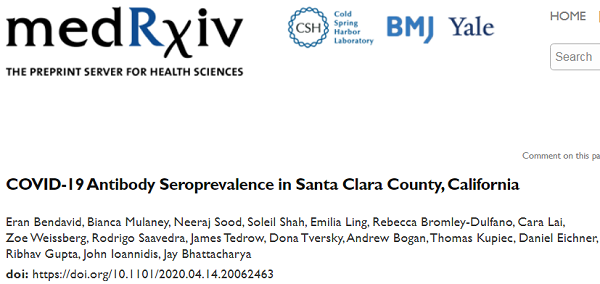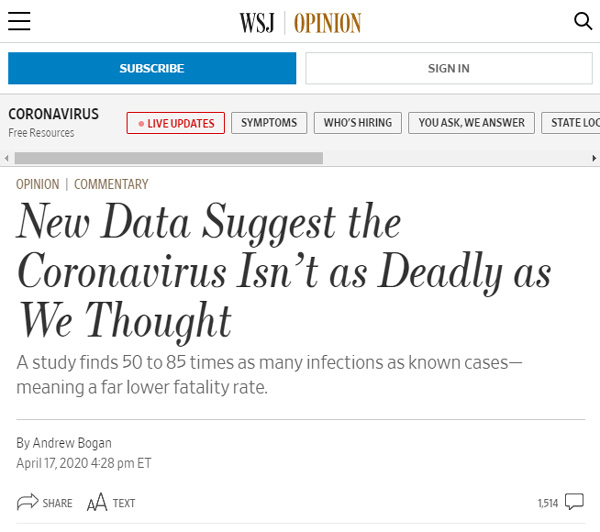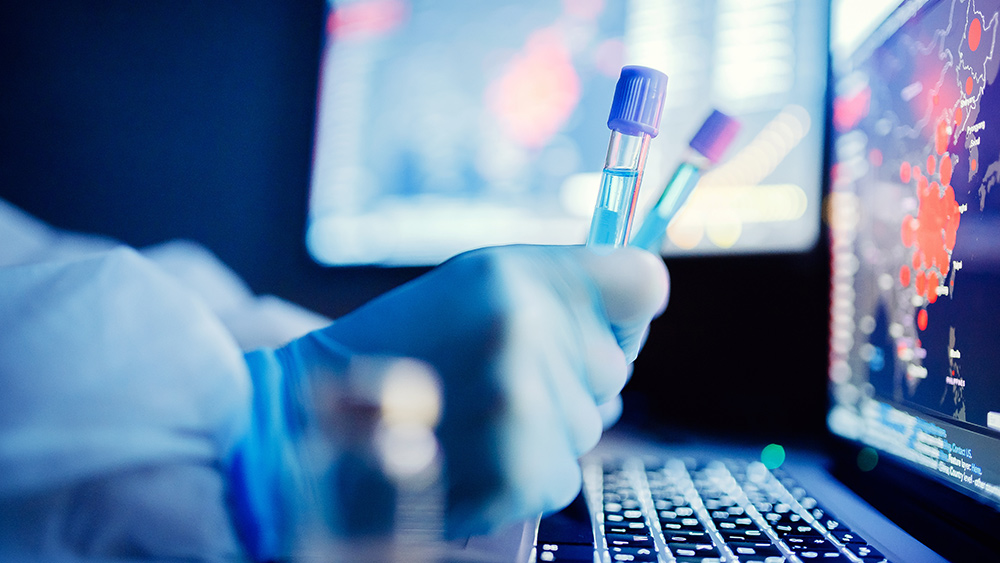BOMBSHELL: Wall Street Journal caught running a Monsanto-style FAKE SCIENCE scam with Stanford researchers to mislead America over coronavirus infections
04/21/2020 / By Mike Adams

Before Bayer acquired Monsanto, the GMO giant had a reputation for faking the science and either bribing or threatening journalists to run stories touting its fake science, usually to claim GMOs were safe or that glyphosate was harmless.
Monsanto would fund its own slanted studies — often by bribing universities with grant money — then pay off scientists to slap their names on these ghostwritten science papers. Once the fake science got published, Monsanto would lean on journalists in Forbes.com and other publications to write up fake news glorifying their fake science.
Now, the Wall Street Journal is doing much the same thing with Stanford researchers, faking the science about covid-19 in order to deceive America, falsely claiming the coronavirus has already infected 55 times more people than currently believed, concluding that the case fatality rate is therefore very low.
We’ve tracked the authors of the WSJ articles and tied them to Stanford University and its pro-China “economic forum” activities that appear to be designed to destabilize the United States with communist-run disinformation attacks surrounding the coronavirus. Keep reading for the full details…
In one recent article, the WSJ claims the fatality rate is nearly as low as the regular flu (0.1%). That article is touting the findings of Stanford researchers who published a highly-publicized paper that (falsely) claimed as many as 81,000 people in Santa Clara county were already infected with coronavirus.
The paper was bogus. It relied on faulty test kits made in China that produce huge numbers of false positives. As we’ve already described in a detailed Natural News article, it turns out that the test likely had 13 false positives for every 1 “true” positive, rendering the study conclusions pointless. Even worse, the study subjects self-selected to participate in the study, and many obviously did so because they believed they had covid-19 symptoms and wanted to get free testing. Thus, the study wasn’t even a “representative” (randomized) population sample to begin with.
But the Wall Street Journal touted the study as a kind of bombshell, seemingly celebrating the good news that the coronavirus was no worse than the flu — an oft-repeated mantra among pandemic denialists who insist the virus is largely a hoax. According to the WSJ, the Stanford study was legitimate, and it used as “representative” sample for testing (which is a lie).
There’s just one huge, glaring problem with all this:
The author of the WSJ article is also a co-author on the fake science paper.
His name is Andrew Bogan, and he’s listed right in the authors section of the paper itself.
Title: COVID-19 Antibody Seroprevalence in Santa Clara County, California
Authors: Eran Bendavid, Bianca Mulaney, Neeraj Sood, Soleil Shah, Emilia Ling, Rebecca Bromley-Dulfano, Cara Lai, Zoe Weissberg, Rodrigo Saavedra, James Tedrow, Dona Tversky, Andrew Bogan, Thomas Kupiec, Daniel Eichner, Ribhav Gupta, John Ioannidis, Jay Bhattacharya
Screen shot:

As you can see from the authors section, Andrew Bogan is a co-author on the paper, yet he writes in the Wall Street Journal as if he’s an independent journalist.
Here’s his article from the WSJ: New Data Suggest the Coronavirus Isn’t as Deadly as We Thought

And here’s a photo from his LinkedIn page:

In the article, he’s citing his own paper, yet he utterly fails to disclose that he’s one of the authors of the paper. “Some experts—including in these pages—have questioned this assumption,” he writes. “They argue that known cases are likely only a small portion of the true number of infections, and thus high case-fatality rates could be off by orders of magnitude.”
Orders of magnitude? “Some authors?” He is one of the authors. And as the author of this WSJ piece, he lies about the accuracy of the study itself.
In one case, he explains, “They studied a representative sample of 3,300 residents to test for the presence of antibodies in their blood…” But it wasn’t a representative sample at all. It was a self-selected sample of people who signed up for free testing, most likely because they suspected they might have had the coronavirus.
Some of these people likely even recruited others to participate, suspecting they, too, might have been infected. As explained in this scientific analysis on Medium.com:
The second mechanism that could significantly enrich the number of COVID-19 cases in the study is if symptomatic or exposed people recruited other symptomatic or exposed people to get tested.
Recall that recruitment of study participants was done through Facebook. People who thought they had symptoms or exposure could be sharing links to the study in private groups, WhatsApp chats, email threads, and the like. If one of those groups was for people who had COVID-19 symptoms or exposure, then it’s game over: you could get a “super-recruiter” event where one person recruits N other enriched people into the study. That could significantly boost the number of positives beyond what you’d see in a random sample of Santa Clara.
Andrew Bogan fails to explain any of this to WSJ readers. “That’s a clear conflict of interest that was not disclosed by the WSJ, shame on them,” explains Chris Martenson in his Peak Prosperity video, which does an outstanding job of exposing the Wall Street Journal’s science fraud that involved Stanford researchers.
Watch that segment, beginning at 26:35:
Stanford researchers tried to hide the fact that the antibody tests were made in China by a biotech company with a horrible track record for accuracy
Even worse, the Stanford researchers tried to bury the fact that the antibody tests they used were made by a Chinese biotech company with a lousy track record for accuracy. As explained on Natural News:
In fact, the study is based almost entirely on false positives due to the faulty test kits that were used by Stanford researchers. Those test kits, it turns out, were made in China by a biotech manufacturer rated at the very bottom in a list of test accuracy rankings. And just like all the other China-made test kits that are exported to the USA, they are intended to create complacency across the USA by making people believe the coronavirus isn’t dangerous at all.
At the time Stanford did the study, there weren’t any FDA-approved COVID-19 antibody tests for clinical use. But for research purposes, the team purchased tests from Premier Biotech in Minnesota. Premier has started marketing a COVID-19 antibody test, but it doesn’t create it. The test listed on the company’s website, and that it appears Stanford used, is from Hangzhou Biotest Biotech, an established Chinese lab test vendor.
There is some additional reason to be skeptical about the particular test used. In another pre-print, researchers from Hospitals and Universities in Denmark rated the Hangzhou-developed test last in accuracy of the nine they tested. In particular, it had only an 87 percent specificity (it misidentified two of 15 negative samples as being positive). That is a far cry from the 99.5 percent calculated by Stanford…
Andrew Bogan didn’t reveal any of this in the WSJ article for obvious reasons. His job was to deceive WSJ readers with bad information while hiding the fact that the entire study was bogus to begin with.
Believe it or not, two more Stanford authors also wrote stories for the Wall Street Journal that claimed the coronavirus was no worse than the flu
But the WSJ fake science scam doesn’t end here. It turns out that two more WSJ writers were also co-authors of the science paper, and one was the lead author!
Their names are Eran Bendavid and Jay Bhattacharya, and they are Stanford researchers who abused their academic positions to produce bad science and then mislead the American public with the most insanely dishonest fake news reporting we’ve seen yet.

See Eran Bandavid’s page at Stanford.

See Jay Bhattacharya’s page at Stanford.
In addition to being co-authors of the bad science paper linked above, they’re also the authors, it turns out, of this March 24th article in the Wall Street Journal entitled: Is the Coronavirus as Deadly as They Say?
In that article, they argue the covid-19 fatality rate is “too high by orders of magnitude.” That means it’s at least 100 times lower than what is believed, which would put the coronavirus death rate below the case fatality rate for the seasonal flu. It’s the old, “It’s no worse than the flu” narrative, now being pushed through the Wall Street Journal by the very same dishonest scientists who co-authored the paper which used bad antibody test kits and bad math to try to claim the same thing.

In their WSJ story, they make one of the most intellectually dishonest junk science claims I’ve ever seen in print.
They claim that professional NBA basketball players are representative of the covid-19 infections across the populations of the cities in which the NBA plays.
This is such a laughably dishonest leap of bad science that the Wall Street Journal should be ashamed for printing it. From the article itself:
The best (albeit very weak) evidence in the U.S. comes from the National Basketball Association. Between March 11 and 19, a substantial number of NBA players and teams received testing. By March 19, 10 out of 450 rostered players were positive… if we extend that lower-bound assumption to cities with NBA teams (population 45 million), we get at least 990,000 infections in the U.S. The number of cases reported on March 19 in the U.S. was 13,677, more than 72-fold lower. These numbers imply a fatality rate from Covid-19 orders of magnitude smaller than it appears.
Huh?
“Shame on the Wall Street Journal for even printing that,” said Peak Prosperity’s Christ Martenson in his video analysis (see above). “This is a little circle-jerk of self-reinforcing stuff,” he warned, talking about how the WSJ prints articles citing studies which are co-authored by the very same dishonest “scientists” who are writing the WSJ articles.
And Chris is right, it is a circle jerk of bad science and dishonest journalism. The Wall Street Journal is now peddling fake science on the coronavirus just like the NYT peddles fake science on climate change.
Why would the Wall Street Journal and Stanford University researchers conspire to deceive America about the case fatality rate of the coronavirus?
It’s worth noting that the narrative of the WSJ and Stanford University researchers is consistent with the communist Chinese party that has tried to downplay the severity of covid-19 by covering up the deaths in its own country (and “disappearing” whistleblower doctors).
We already know that China is essentially bribing scientists across hundreds of U.S. universities and research centers, offering them grant money to push communist China’s narratives that are meant to destabilize the United States of America.
A Harvard professor was charged this year with lying about a $1.5 million research scheme that was essentially a bribe from China. Via the NY Post:
The chairman of Harvard University’s chemistry department was charged Tuesday with lying to the US Defense Department about his dealings with Chinese research agencies while receiving federal research funds, officials said. Charles Lieber is accused of receiving more than $1.5 million to establish a lab and do research at Wuhan University, according to prosecutors, who said he was paid hundreds of thousands more over several years…
Now, we learn that Stanford runs a “Stanford China Economic Forum” which is billed as providing “research and collaboration” with China.

That China Economic Forum is part of the Stanford King Center on Global Development. And guess who’s found as a “faculty affiliate” of the Stanford King Center on Global Development?
None other than Eran Dendavid, the lead author of the bad science paper as well as the co-author of the WSJ article that claimed coronavirus was no worse than the flu.
Starting to get the picture here?
Oh, and not to be left out, his co-author on both the bad science paper and the fake news WSJ article is Jay Bhattacharya who is also listed as a “faculty affiliate” of the Stanford King Center on Global Development.
So let me get this straight:
- The Wall Street Journal runs articles claiming the coronavirus is no worse than the flu and that case fatality rates are “orders of magnitude” lower than what anyone else is reporting.
- The WSJ articles turn out to be written by three people who are all listed as co-authors of a bad science paper, non-peer-reviewed, which came out of Stanford.
- None of the WSJ articles mention any conflicts of interest even though one of the key articles cites the same study in which the WSJ author is also the science paper co-author. (Hmmm…)
- The antibody test kits used in the study were made by a Chinese biotech company with a horrible accuracy record, producing enormous numbers of false positives, but the paper authors try to hide the origins of the antibody test kits, dishonestly claiming much higher accuracy than what the tests actually produce.
- Two of the three study authors are associated with the Stanford King Center on Global Development that appears to be a mouthpiece for the economic dominance of communist China, which hosts the “Stanford China Economic Forum.”
- The WSJ articles and Stanford paper just happen to perfectly align with communist China’s preferred narrative that tries to claim the coronavirus is no big deal, possibly to sow chaos and complacency across the USA.
- Breitbart.com and other conservative media outlets fell for the scam and reported the bogus Stanford research as “fact,” not bothering to look at the numbers or see the obvious conflicts of interest among the lead researchers.
Can you say “fake news?”
Fake science.
Fake narratives.
All designed to breed complacency among the American people, convincing people to reopen the economy without taking adequate precautions, thereby putting America back on track to millions of deaths if the exponential spread of the virus is allowed to continue.
Sounds like a communist plot to me. What do you think?
h/t to Chris Martenson from PeakProsperity.com who initially broke the story about the WSJ fake science. We took it from there and did more research on these Stanford researchers, exposing their roles in all this.
Share this story everywhere. Use this science.news link to share it, since science.news is not as censored as our other websites:
Tagged Under: Andrew Bogan, Eran Bendavid, fake news, hoax, Jay Bhattacharya, science blowns, science fraud, Wall Street journal, WSJ
RECENT NEWS & ARTICLES
ScienceFraud.News is a fact-based public education website published by Science Fraud News Features, LLC.
All content copyright © 2018 by Science Fraud News Features, LLC.
Contact Us with Tips or Corrections
All trademarks, registered trademarks and servicemarks mentioned on this site are the property of their respective owners.

















